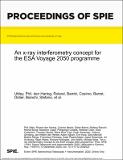An x-ray interferometry concept for ESA's Voyage 2050 programme
Author(s)
Uttley, Phil; den Hartog, Roland H; Bambi, Cosimo; Barret, Didier; Bianchi, Stefano; Bursa, Michal; Cappi, Massimo; Casella, Piergiorgio; Cash, Webster; Costantini, Elisa; Dauser, Thomas; Diaz Trigo, Maria; Gendreau, Keith; Grinberg, Victoria; den Herder, Jan-Willem A; Ingram, Adam; Kara, Erin; Markoff, Sera; Mingo, Beatriz; Panessa, Francesca; Poppenhäger, Katja; Rozanska, Agata; Svoboda, Jiri; Wijers, Ralph; Willingale, Richard; Wilms, Jörn; Wise, Michael; ... Show more Show less
DownloadPublished version (1.838Mb)
Publisher Policy
Publisher Policy
Article is made available in accordance with the publisher's policy and may be subject to US copyright law. Please refer to the publisher's site for terms of use.
Terms of use
Metadata
Show full item recordAbstract
© 2020 SPIE We have proposed the development of X-ray interferometry as part of ESA's Voyage 2050 programme, to reveal the universe at high energies with ultra-high spatial resolution. With only a 1 m baseline, which could be accommodated on a single spacecraft, X-ray interferometry can reach 100 µas resolution at 10 Å (1.24 keV) and exceed that of the Event Horizon Telescope at 2 Å (6.2 keV). A multi-spacecraft 'constellation' interferometer would resolve well below 1 µas. Here we focus on the single-spacecraft interferometer design and discuss the process of fringe detection and image reconstruction from multiple baselines, showing simulated images of test cases from our Voyage 2050 White Paper. We also discuss the challenges and feasibility of reaching the technical requirements needed for a single-spacecraft interferometer. Most key requirements are already feasible or within easy reach. Besides a ground-based testbed, covered elsewhere in these proceedings, the most important areas for development include large format, small-pixel X-ray detectors and pointing which is stable or can be reconstructed to tens of µas precision.
Date issued
2020Department
MIT Kavli Institute for Astrophysics and Space ResearchJournal
Proceedings of SPIE - The International Society for Optical Engineering
Publisher
SPIE-Intl Soc Optical Eng
Citation
Uttley, Phil, den Hartog, Roland H, Bambi, Cosimo, Barret, Didier, Bianchi, Stefano et al. 2020. "An x-ray interferometry concept for ESA's Voyage 2050 programme." Proceedings of SPIE - The International Society for Optical Engineering, 11444.
Version: Final published version